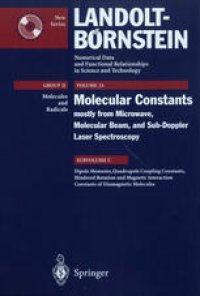
Ebook: Dipole Moments, Quadrupole Coupling Constants, Hindered Rotation and Magnetic Interaction Constants of Diamagnetic Molecules
Author: W. Hüttner (eds.)
- Tags: Landolt-Börnstein, Atomic and Molecular Structure and Spectra
- Series: Landolt-Börnstein - Group II Molecules and Radicals 24C : Molecules and Radicals
- Year: 2002
- Publisher: Springer-Verlag Berlin Heidelberg
- Edition: 1
- Language: English
- pdf
Volume II/24 presents the spectroscopic data on diamagnetic and paramagnetic molecules as well as on molecular ions and radicals up to date considering the publications up to and partly including 1997. The spectroscopic information collected in this volume has been obtained principally from gas phase microwave measurements. In addition, gas phase data have been included derived from methods related to microwave spectroscopy by employing a coherent radiation source. These are molecular beam techniques, radio frequency spectroscopy, electron resonance spectroscopy, laser spectroscopy, double resonance and saturation techniques. Some other methods are considered if the accuracy of the derived molecular parameters is comparable to that of microwave spectroscopy owing to a good statistics in the analysis of data, and no microwave data are available. Examples would be Fourier infrared spectroscopy or laser induced fluorescence.
Volume II/24 presents the spectroscopic data on diamagnetic and paramagnetic molecules as well as on molecular ions and radicals up to date considering the publications up to and partly including 1997. The spectroscopic information collected in this volume has been obtained principally from gas phase microwave measurements. In addition, gas phase data have been included derived from methods related to microwave spectroscopy by employing a coherent radiation source. These are molecular beam techniques, radio frequency spectroscopy, electron resonance spectroscopy, laser spectroscopy, double resonance and saturation techniques. Some other methods are considered if the accuracy of the derived molecular parameters is comparable to that of microwave spectroscopy owing to a good statistics in the analysis of data, and no microwave data are available. Examples would be Fourier infrared spectroscopy or laser induced fluorescence.